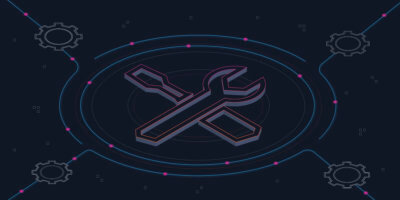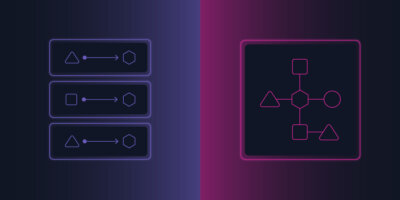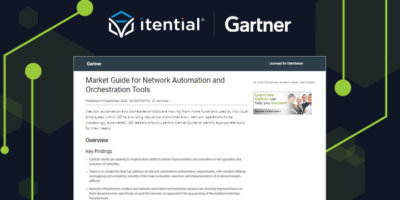According to Gartner, 65 percent of organizations that deployed robotic process automation will introduce artificial intelligence, including machine learning and natural language processing algorithms, by 2022. At the same time, network automation initiatives have begun to mature and expand — moving from automations of common tasks to larger use cases that address multiple technologies and domains, as well as multiple business groups within the organization. These larger automation scenarios require a substantial investment of time, resources, and expenses for proper planning, design, development, testing, and implementation.
To make network management easier and to maximize network automation’s effects on business operations, organizations will need to coordinate activities across their automation, robotic process automation (RPA), artificial intelligence (AI) and machine learning (ML) initiatives. Service providers and enterprises must determine how to integrate all four by applying the optimal technology for each unique business problem to maximize business impact.
Defining Automation, RPA, AI, and ML
To best determine the role of coordinating these tools, let’s first identify their exact roles within an enterprise.
Automation is a term used to describe all aspects of programmable approaches to automating network configuration and control. Benefits include centralized management and coordinated execution of changes to network devices and systems, including deployment, operations, and maintenance of network devices and network services. It also provides the execution of simple or complex business processes that require careful attention to order of operations, with a focus on reducing time spent on repetitive tasks and decreasing and eliminating human errors.
Artificial intelligence (AI) is a broad term used to describe techniques to simulate how the human brain thinks, by applying “advanced analysis and logic-based techniques, including machine learning, to interpret events, support and automate decisions, and take actions.” Machine learning (ML) is a subset of AI, where “algorithms are composed of many technologies (such as deep learning, neural networks and natural language processing), used in unsupervised and supervised learning, that operate guided by lessons from existing information.”
Turning to robotic process automation (RPA), Gartner defines this term as “a productivity tool that allows a user to configure one or more scripts (which some vendors refer to as ‘bots’) to activate specific keystrokes in an automated fashion.” This essentially replicates the interactions performed by an application end user or system operator.
To simplify the distinction between these technologies even further, it’s important to understand that network automation is focused on enabling programmable (machine-to-machine) interactions with the network. AI is a blanket term that covers many technologies related to simulated thinking, while ML focuses on using existing data to solve specific problems, and RPA is used to automate end-user interaction with existing applications (people-to-machine).
From Task Automation to Full Lifecycle Automation
In the early phases of network automation, most of the efforts were focused on simplifying and condensing repetitive tasks to gain efficiencies. Business processes remained largely unchanged, with automation primarily applied to standalone tasks within the process. The impact of these efforts was meaningful for individuals — an engineer could perform 100 assignments in the time it previously took to complete one — but the results were not transformational for the organization. Automation tools are shifting from providing niche solutions for disparate functions to providing robust solutions that allow network operations to be increasingly automated. We describe this as a shift from task-centric automation to full lifecycle automation.
This shift and next phase of automation will require an evolution from task automation to full lifecycle automation and orchestration. This is where the need to coordinate automation, RPA, AI and ML initiatives is critical for continued business success. While some enterprises have adopted some, if not all, of these tools, they are siloed and lack an integrated strategy, which challenges future scaling initiatives. As such, this process will require proper design and strategic planning to maximize business impact from these processes, which calls for enterprises to map out how these processes will work together.
Hyperautomation is an effective approach to coordinating this transformation. According to Gartner, “hyperautomation refers to an effective combination of complementary sets of tools that can integrate functional and process silos to automate and augment business processes.” At Itential, we believe two of the most promising opportunities for hyperautomation will be gained through synergies between RPA and network automation and between ML and network automation.
RPA and Network Automation
The reality today is that traditional methods of managing the network only address between 30 minutes to two hours of a typical network change process that can span weeks of time, including ten to 20 hours of manual effort along with multiple hours or days of idle time. On average, network operators implementing automation only end up addressing between 10 and 20 percent of the possible work involved and ignoring 80 to 90 percent of the process that they could be automating.
So, what does the ignored 80 percent of the automatable network processes look like? Beyond execution, organizations are ignoring the opportunity to optimize and automate the entire network change process, from planning and scheduling to all the pre- and post-network health checks and inventory and change request updates. Along with these activities, there is idle time created by hand-offs between tasks. For example, a planning team may perform a scheduling task and hand the job off to an engineer to gather network addressing information. This hand-off may happen manually, via email, or in a ticketing system, but typically there is some amount of time that elapses between when the planner finishes their work, and the engineer begins theirs.
The resources required and transition time between these various stages call for an extensive amount of swivel-chairing between systems and the various people across the organization who must manually interact with disparate network management systems. Each of these manual steps has a cost and increases the error rate of network changes, driving fear and uncertainty in the organization every time a change needs to be made. To achieve end-to-end automation, organizations need to broaden the scope of their automation efforts to better align and increase the velocity at which they can deliver change.
With that said, we see RPA as a step toward a fully automated network, not an end goal. RPA’s focus is on streamlining interactions with existing applications, while the end goal would be to migrate off the existing applications (with their keyboard/user/human-centric focus on input) toward programmable systems. This will introduce a machine-to-machine-centric model, which in turn provides more speed, flexibility, and capacity while shortening time intervals by eliminating idle time. We expect RPA to continue to be used in coordination with network automation in the short term, especially in situations where a system or application that is critical to a specific business process does not have an application programming interface (API) for exposing its functionality.
For example, an internally developed inventory system may not expose an API. Instead, it may force users to interact with the database only through its user interface. If such an inventory system contained data related to the assignment of virtual local area networks (VLAN), and the network team wanted to automate their process for data center creation and operations, they would use a network automation platform. This will create automations for the end-to-end processes while using RPA as a sub-process to automate the interaction with the inventory system.
Ultimately, utilizing RPAs with an automation platform allows organizations to leverage tribal knowledge that teams possess without enforcing a steep learning curve for software development and new enterprise tools. This combination supports most organizations’ goals of extending automation initiatives beyond simple data analysis and single-step mundane tasks to seamless end-to-end automation.
Machine Learning and Network Automation
For automation to become truly transformative, operators need to revisit and redesign their business processes to reflect a machine-centric paradigm. By automating an entire process, not just individual tasks, the operator gains the flexibility to do much more in much less time with fewer resources—making innovation possible.
When the marginal cost and time to provision a service, or to deploy a new network function, becomes trivial, the service provider can focus on creating new services, composed of capabilities that were previously too costly to manage. Engineering and operations teams can focus their attention on strategic activities of greater value that require their domain expertise instead of performing routine, time-intensive, repetitive activities.
Network automation also solves one of the main challenges in using ML for network engineering and operations: availability of and access to large volumes of data. In network environments where activities are performed manually, there are no mechanisms to capture data such as when a specific task was performed, what the inputs and outputs were for the task, how long the task took to perform, what errors were encountered, and what the state of the network was at the time of the change. With no data set, there is nothing to point the ML algorithms to. One of the main benefits of network automation is the ability to capture a huge amount of data related to the execution of tasks. Network engineers can use this as a dataset for the ML systems, enabling them to use ML to improve areas such as performance, availability, capacity, latency and security.
The evolution of networks and their management approaches has undergone tremendous transformation as businesses widely embrace digital transformation efforts. Looking ahead, the future of automation and orchestration will be machine-centric and require coordination and strategic planning initiatives to lead to successful business results. As the rate of change in network technologies increases, the value of a machine-centric model becomes even greater and creates opportunities to exploit synergies between ML, RPA, and network automation. These technologies have the potential to deliver unique, differentiated, high-value services, but only if the operator transforms the way they are designing and executing their business processes, and only if they utilize tools and platforms that have the capabilities to deliver true end-to-end, machine-centric automation.
Article originally published in Pipeline.






